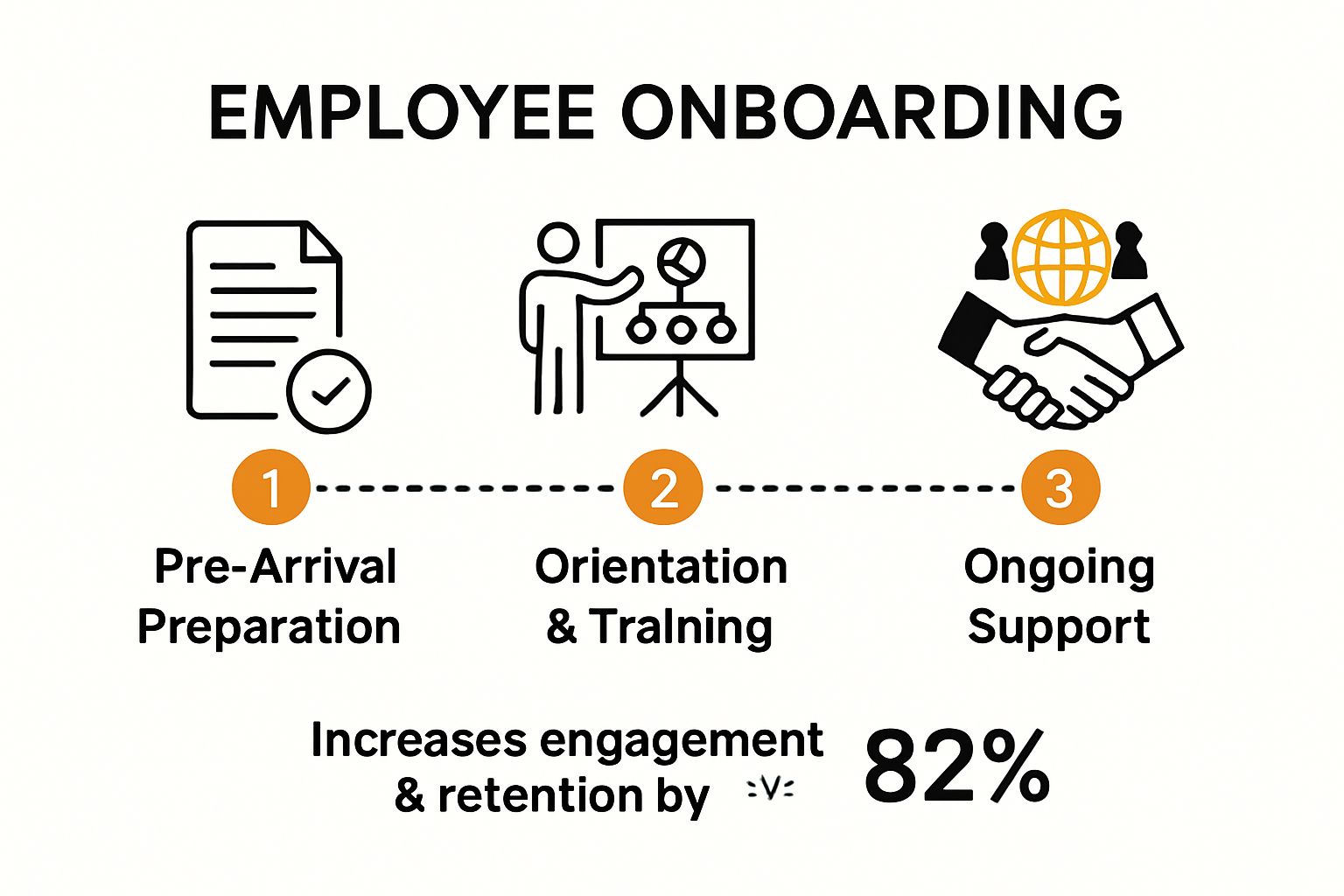A strong employee onboarding process can transform how quickly new hires contribute and connect, and companies with structured onboarding see retention rates improve by up to 50 percent. Most people assume onboarding just means paperwork and a tour, but that old approach leaves nearly 9 out of 10 organizations missing out. What actually makes onboarding work is a blend of genuine welcome, smart training, and steady support that sets the stage for engaged and productive teams.
Table of Contents
- Understanding The Employee Onboarding Process
- Key Steps For A Successful Onboarding Experience
- Best Practices For Managers And HR Leaders
- Common Mistakes And How To Avoid Them
Quick Summary
| Takeaway | Explanation |
|---|---|
| Effective onboarding boosts retention and productivity | A well-structured onboarding process can improve employee retention by up to 50% and enhance productivity, according to research. |
| Personalize the onboarding experience for each employee | Customized onboarding strategies accounting for individual backgrounds and skills lead to higher engagement and satisfaction. |
| Establish ongoing support through regular check-ins | Continuous feedback and scheduled meetings during initial months help new hires integrate smoothly into the organization. |
| Integrate cultural aspects into onboarding | Addressing emotional and cultural integration is crucial for new employees to feel connected and supported within the team. |
| Avoid information overload through phased delivery | Spreading essential information over time prevents cognitive overload, making it easier for new hires to absorb key messages. |
Understanding the Employee Onboarding Process
The employee onboarding process represents a critical organizational strategy for integrating new team members effectively and efficiently. It goes far beyond a simple orientation day, serving as a comprehensive approach to welcoming, preparing, and fully integrating new employees into the company’s culture, workflows, and expectations.
The Strategic Importance of Onboarding
Effective employee onboarding is more than paperwork and introductions. Gallup research reveals that only 12% of companies do an excellent job of onboarding new employees, highlighting a significant opportunity for organizational improvement. A well-designed employee onboarding process can dramatically impact employee retention, productivity, and overall organizational success.
The primary goals of a robust onboarding process include helping new employees understand their roles, integrating them into the company culture, providing necessary tools and resources, and establishing clear performance expectations. SHRM Foundation emphasizes that structured onboarding programs can improve new hire retention by up to 50% and increase productivity by accelerating the time it takes for employees to become fully contributing team members.
Key Components of an Effective Onboarding Strategy
A comprehensive employee onboarding process typically involves multiple interconnected stages. These stages are designed to create a smooth transition for new hires, ensuring they feel welcomed, supported, and equipped to succeed. The process usually encompasses administrative tasks, role-specific training, cultural integration, and ongoing support.
Key components include comprehensive documentation and paperwork management, initial orientation sessions, role-specific training programs, introduction to company culture and values, assignment of mentors or buddies, clear communication of performance expectations, and structured check-in meetings during the initial employment period.
To clarify the main elements that should be included in any effective onboarding program, the following table summarizes the key components and what each entails.
| Key Component | Description |
|---|---|
| Documentation & Paperwork | Manage administrative forms, credentials, and policies for new hires |
| Initial Orientation | Conduct sessions to introduce company overview, mission, and values |
| Role-Specific Training | Provide training directly relevant to new employee’s job and responsibilities |
| Cultural Integration | Foster connection to company culture, team, and organizational values |
| Assignment of Mentor/Buddy | Pair new employee with experienced staff for guidance and support |
| Communication of Expectations | Clearly outline performance standards, goals, and evaluation criteria |
| Structured Check-Ins | Schedule regular meetings to review progress and address any concerns |
Organizations that invest time and resources into developing a strategic employee onboarding process recognize that the first few weeks and months are crucial in determining an employee’s long-term engagement, performance, and commitment. By creating a welcoming, informative, and supportive environment, companies can significantly reduce early-stage turnover and build a strong foundation for employee success.
Ultimately, the employee onboarding process is not a one-time event but an ongoing journey of integration, learning, and mutual adaptation between the new employee and the organization. It requires intentional design, consistent execution, and a genuine commitment to supporting new team members as they begin their professional journey within the company.
Key Steps for a Successful Onboarding Experience
Creating a successful onboarding experience requires a strategic and comprehensive approach that goes beyond simple administrative tasks. Organizations must design a multi-dimensional process that addresses the professional, emotional, and cultural integration of new employees.
Pre-Arrival Preparation and Welcome
Successful onboarding begins before the employee’s first day. The U.S. Department of the Interior highlights the importance of preparatory steps that set the stage for a positive employee experience. This includes sending welcome packages, preparing workstations, setting up necessary technology access, and creating a structured first-week schedule.
Key pre-arrival activities involve sending personalized welcome emails, sharing detailed first-week schedules, preparing digital access credentials, and arranging introductory meetings with team members. Organizations can also send onboarding materials electronically, allowing new hires to review company policies and complete paperwork in advance, which streamlines the initial integration process.
Comprehensive Orientation and Training
Research from Wikipedia indicates that effective orientation programs encompass multiple dimensions of organizational integration. This includes formal meetings, video presentations, printed materials, and computer-based training that comprehensively outline the organization’s operations and culture.
A robust orientation should cover several critical areas: company history and mission, organizational structure, role-specific expectations, performance metrics, communication protocols, and available professional development resources. Interactive sessions that allow new employees to ask questions and engage with different departments can significantly enhance understanding and engagement.
Companies should design training programs that are not just informative but also interactive and engaging. This might include shadowing experienced team members, participating in simulated work scenarios, and receiving mentorship from seasoned professionals. Learn more about team collaboration strategies that can enhance the onboarding process and foster seamless team integration.
Ongoing Support and Check-In Mechanisms
Onboarding is not a one-time event but a continuous process of integration and support. Organizations should establish regular check-in mechanisms during the first few months of employment. These might include weekly one-on-one meetings with managers, 30-60-90 day performance reviews, and structured feedback sessions.

Effective ongoing support involves creating clear communication channels, providing resources for continuous learning, and maintaining a supportive environment that encourages questions and professional growth. Managers play a crucial role in this phase, helping new employees navigate organizational dynamics, understand unwritten cultural norms, and feel genuinely welcomed and valued.
By implementing a holistic, thoughtful onboarding experience, organizations can significantly improve employee engagement, reduce early-stage turnover, and create a strong foundation for long-term professional relationships. The key is to view onboarding as an investment in human potential rather than a mere administrative requirement.
Best Practices for Managers and HR Leaders
Managers and HR leaders play a pivotal role in creating a successful employee onboarding experience that transforms new hires into engaged, productive team members. Their strategic approach and intentional actions can significantly impact an employee’s initial perception and long-term commitment to the organization.
Strategic Onboarding Planning and Personalization
Research from the International Journal of Human Resource Studies emphasizes the importance of customized onboarding processes that recognize individual employee needs. Managers must move beyond standardized approaches and develop personalized integration strategies that consider each new hire’s unique background, skills, and potential.
Effective onboarding planning involves creating detailed, role-specific orientation roadmaps that outline clear expectations, performance metrics, and professional development opportunities. This approach requires collaboration between HR departments and direct managers to ensure a comprehensive and meaningful introduction to the organization. Learn more about collaborative decision-making strategies that can enhance the onboarding process and team alignment.
Establishing Mentorship and Support Structures
Creating robust support systems is crucial for successful employee integration. Managers should implement structured mentorship programs that pair new employees with experienced team members who can provide guidance, answer questions, and help navigate organizational culture. These mentorship relationships go beyond formal training, offering informal learning opportunities and emotional support during the critical initial employment period.
Key mentorship practices include:
- Matching criteria: Carefully select mentors based on professional expertise, communication skills, and cultural alignment.
- Clear expectations: Establish specific goals and time commitments for mentorship relationships.
- Regular check-ins: Schedule consistent meetings to monitor progress and address potential challenges.
- Feedback mechanisms: Create channels for both mentors and new employees to provide insights about the mentorship experience.
Continuous Feedback and Performance Integration
Successful onboarding extends far beyond the first few weeks of employment. Managers must establish continuous feedback loops that support new employees’ professional growth and organizational integration. This involves implementing structured performance review processes, providing regular constructive feedback, and creating opportunities for open communication.
Effective continuous feedback strategies include:
- Frequent one-on-one meetings: Schedule regular check-ins to discuss performance, challenges, and professional development.
- 360-degree feedback: Incorporate input from multiple team members to provide comprehensive performance insights.
- Goal alignment: Help new employees understand how their individual objectives connect to broader organizational goals.
- Professional development planning: Work collaboratively to identify skill enhancement opportunities and career progression paths.
By adopting these best practices, managers and HR leaders can transform the onboarding process from a transactional administrative task into a strategic opportunity for talent development and organizational culture building. The investment in thoughtful, personalized onboarding approaches pays significant dividends through improved employee engagement, faster productivity ramp-up, and enhanced long-term retention.

Common Mistakes and How to Avoid Them
The employee onboarding process is fraught with potential pitfalls that can undermine organizational efforts to successfully integrate new team members. Recognizing and proactively addressing these common mistakes is crucial for creating a positive, effective onboarding experience that supports both employee and organizational success.
Overlooking Personalization and Individual Needs
One of the most significant mistakes organizations make is treating onboarding as a one-size-fits-all process. Research from Deloitte highlights that generic onboarding approaches fail to engage employees and can lead to early disengagement and potential turnover.
To avoid this pitfall, organizations must develop personalized onboarding strategies that consider:
- Individual background: Recognizing each employee’s unique skills, experiences, and learning styles.
- Role-specific requirements: Tailoring orientation and training to specific job responsibilities.
- Personal motivations: Understanding what drives each new employee’s professional aspirations.
Learn more about creating effective team collaboration strategies that can help managers develop more personalized onboarding approaches.
Information Overload and Lack of Structured Support
Another critical mistake is overwhelming new employees with excessive information during the initial onboarding phase. SHRM Foundation suggests that information bombardment can lead to cognitive overload, reducing retention and understanding of crucial organizational information.
Effective strategies to mitigate information overload include:
- Phased information delivery: Spread critical information across multiple weeks
- Interactive learning methods: Use varied training techniques like workshops, mentorship, and hands-on experiences
- Clear prioritization: Highlight most important information and provide context
- Ongoing support mechanisms: Establish continuous learning and support channels
Neglecting Cultural and Emotional Integration
Many organizations focus exclusively on administrative tasks and technical training, overlooking the critical aspect of cultural and emotional integration. This approach can leave new employees feeling disconnected and isolated, potentially leading to decreased engagement and higher turnover rates.
Key approaches to address cultural integration include:
- Social integration opportunities: Create structured networking events and team-building activities
- Clear communication of organizational values: Develop comprehensive programs that explain company culture beyond written documents
- Emotional support systems: Implement mentorship programs and regular check-in mechanisms
- Psychological safety: Foster an environment that encourages questions, feedback, and open communication
By recognizing and proactively addressing these common onboarding mistakes, organizations can create a more holistic, engaging, and effective integration process.
The following table lists frequent onboarding mistakes highlighted in the article, along with effective strategies to avoid each one, making it easier for HR teams and managers to reference.
| Common Mistake | How to Avoid |
|---|---|
| Generic, non-personalized onboarding | Customize orientation based on background, role, and motivations |
| Overwhelming information overload | Deliver information in phases and use interactive training methods |
| Lack of structured support and check-ins | Establish ongoing feedback channels, mentorship, and regular meetings |
| Neglecting cultural and emotional integration | Provide social opportunities, communicate values, and ensure psychological safety |
The goal is to move beyond transactional onboarding to a comprehensive approach that supports new employees’ professional and personal growth, ultimately contributing to long-term organizational success and employee retention.
Frequently Asked Questions
What is the employee onboarding process?
The employee onboarding process is a strategic approach to integrating new hires into an organization, which includes welcoming them, providing necessary training, and helping them understand their roles and the company culture.
Why is effective onboarding important for employee retention?
Effective onboarding significantly improves retention rates, with studies indicating it can boost retention by up to 50%. A well-structured onboarding experience leads to higher employee engagement and productivity.
What are some key components of an effective onboarding strategy?
Key components include personalized orientation sessions, role-specific training, cultural integration, mentorship assignments, communication of performance expectations, and regular check-ins during the initial employment period.
How can organizations avoid common onboarding mistakes?
Organizations can avoid mistakes by personalizing the onboarding experience, delivering information in phases to prevent overload, establishing ongoing support mechanisms, and addressing both cultural and emotional aspects of integration.
Take the Complexity Out of Employee Onboarding With Gammatica
Are you frustrated with confusing onboarding steps, lost paperwork, or missed follow-ups? Many workplaces struggle to give new hires a smooth start, which brings stress, wasted time, and missed opportunities. As highlighted in the article, structured support, streamlined communication, and ongoing check-ins are critical for retention and engagement. But doing this manually drains precious hours and leaves room for mistakes. Imagine if your onboarding checklist, team training, and progress tracking could all run themselves, making every new team member feel valued from day one.

With Gammatica, you can automate your onboarding process, assign tailored checklists, and schedule regular reviews that support each employee’s journey. Move beyond information overload and never let important details slip through the cracks. Discover how you can reclaim up to 16 hours weekly, reduce the risk of new hire turnover, and create a culture of organized, efficient integration using our intuitive platform. Take the first step toward results-driven onboarding. Visit Gammatica.com now to explore the features that make onboarding truly easy and effective for managers and teams alike.
Recommended
- Lead Management for Beginners: 2025 Guide for Teams and Leaders | Gammatica
- Automation for Small Businesses: Essential Strategies for 2025 | Gammatica
- How to Manage Tasks Effectively in 2025: Proven Strategies for Leaders | Gammatica
- Collaborative Decision Making for Leaders: Strategies for 2025 | Gammatica



